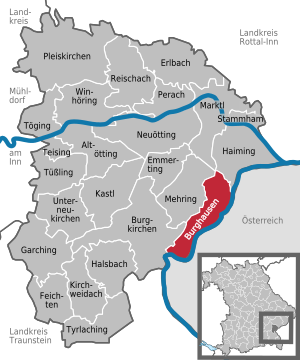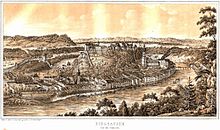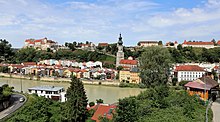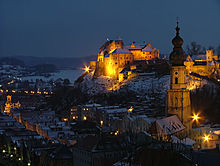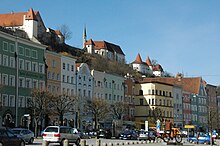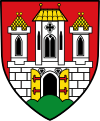Burghausen
| coat of arms | Germany map | |
|---|---|---|
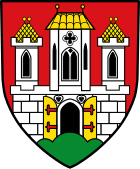
|
Coordinates: 48 ° 10 ′ N , 12 ° 50 ′ E |
|
| Basic data | ||
| State : | Bavaria | |
| Administrative region : | Upper Bavaria | |
| County : | Altötting | |
| Height : | 421 m above sea level NHN | |
| Area : | 19.81 km 2 | |
| Residents: | 18,713 (Dec. 31, 2019) | |
| Population density : | 945 inhabitants per km 2 | |
| Postal code : | 84489 | |
| Area code : | 08677 | |
| License plate : | AÖ, LF | |
| Community key : | 09 1 71 112 | |
| LOCODE : | DE BHN | |
| City structure: | 33 districts | |
City administration address : |
Stadtplatz 112 84489 Burghausen |
|
| Website : | ||
| First Mayor : | Florian Schneider ( SPD ) | |
| Location of the city of Burghausen in the Altötting district | ||
The old ducal city of Burghausen is the most populous city in the Upper Bavarian district of Altötting . The powerful municipality is located on the Salzach , which forms the border with Austria here. Burghausen Castle , which, at 1,051 meters, is the longest castle complex in the world, extends on a ridge above the old town . In the late Middle Ages, Burghausen was an important secondary residence of the Bavarian rulers, which was also manifested in the fact that the city was the seat of one of the four (later five) tax offices of Bavaria for centuries after the reunification of the sub-duchies and thus the administrative center. This is also reflected in the architecture of the city. Burghausen is now part of the Inn-Salzach tourist region .
geography
The city lies at an altitude of around 360 m above sea level. NHN on the Salzach up to 480 m above sea level. NHN at the Kümmernis Chapel.
Neighboring communities
- Burgkirchen an der Alz
- Haiming
- Hochburg-Ach ( Upper Austria )
- Mehring (Upper Bavaria)
- St. Radegund ( Upper Austria )
Outline of the urban area
In addition to the main town, the urban area includes another 32 officially named municipal parts:
|
history
The cityscape today is essentially characterized by two decisive phases of development: on the one hand by its importance as a residential city in the late Middle Ages , on the other hand by the industrialization of the city as part of the Bavarian chemical triangle, which began at the beginning of the 20th century . Most of Burghausen Castle and the medieval old town have been preserved, and to the north and west, modern industrial , commercial and residential areas have expanded as a new town on areas formerly used for agriculture and forestry since the 1910s .
Early days
There is no exact date when Burghausen was founded, apparently the place has been inhabited for thousands of years. Excavations in previous years, especially from 2002 to 2004 on the castle grounds, brought a number of relics from the Bronze and Iron Ages to light. Celtic fibula parts and Roman coins from several centuries were discovered earlier .
middle Ages
Between the 6th and 8th centuries there was probably a small settlement as a customs post on the banks of the Salzach river below the castle, in the area of today's old town .
The oldest written mention of Burghausen that has survived to this day dates back to 1025. In that year the city was named in a document as an imperial property when the Roman-German King and later Emperor Konrad II appointed the Counts of Burghausen to administer the fiscal property. With the death of Gebhard II, this noble family died out in 1168 and Duke Heinrich the Lion from the noble family of the Guelphs , who at that time was known as Heinrich III. Duke of Saxony and as Heinrich XII. was also Duke of Bavaria , took the city for a few years in his possession.
After Heinrich the Lion was ousted in 1180, the town-like settlement passed into the domain of the Wittelsbachers for more than 700 years . The granting of city rights is presumed to have occurred shortly after 1180, but there is no evidence from sources. From 1255, after the first division of Bavaria , Burghausen experienced a political and economic boom as the second residence of the Lower Bavarian dukes. The main source of income was the trade with salt from Hallein , which landed in Burghausen, customs clearance was then transported by land. The landing stage was the Mautnerschloss , which is used today as a seminar and event building .
In 1307 the existing pre-urban law of the medieval commune was codified as city law. In the first half of the 14th century, Emperor Ludwig the Bavarian granted the city several important privileges . At the end of the 14th century, Burghausen became the administrative center, initially as Vitztum . Especially under the last three Lower Bavarian dukes Heinrich , Ludwig and Georg , called the rich, Burghausen experienced a heyday and heyday between 1393 and 1503, which still shapes the cityscape today.
Modern times
After the Landshut War of Succession , Burghausen received one of the four rent offices in 1507 and thus capital status in the newly organized Bavaria. 1527 appears as pastor of Burghausen Christoph Langenmantel , 1518 escape helper Martin Luther from Augsburg . As a pastor in Burghausen, at the express request of Duke Wilhelm IV , he was also given the parish of Feichten an der Alz , because he had “made many contributions in Italy and Bavaria” .
The loss of income from the salt trade due to the establishment of the ducal salt monopoly in 1594 meant a significant turning point for the city. As a result of this, Burghausen experienced a more than 300 year long administrative and economic loss of importance. The many armed conflicts in the following centuries, such as the Thirty Years' War (1618–1648), a series of wars of succession ( 1701–1714 and 1740–1745 ) and the Napoleonic Wars (1792–1815) also brought great hardship to Burghausen and its surroundings. As early as 1763, Burghausen had been appointed a garrison in connection with the large number of armed conflicts .
As a result of the Bavarian War of Succession of 1778/79 and the subsequent Peace of Teschen , Austria was granted all areas east of the Salzach and Inn, from Passau in the north to Salzburg in the south . With the loss of the Innviertel , Burghausen became a border town and thus also lost its economic hinterland. The reforms of the Bavarian Minister Maximilian von Montgelas led to the dissolution of the government in 1802, and in 1807 the title of capital was revoked. From 1807 the Innviertel belonged to Bavaria again for nine years. In 1808, Burghausen briefly became the capital of the newly created Salzach district again , until the seat of government was relocated to Salzburg in 1810. After that, the loss of importance of Burghausen continued. From 1849 to 1862 the energetic painter, district judge and patron Georg Wiesend founded a number of social institutions in the city, including a hospital for the poor, led archaeological excavations and took care of the renovation of the Hedwig Chapel at Burghausen Castle and the new building of the chapel in honor the Wilgefortis on the nearby Hechenberg. In doing so, he wanted to atone for the inglorious role of his predecessor Franz Graf von Armansperg during the secularization , when church property, which was valuable in terms of art history, was brutally auctioned off. In 1891 the garrison then withdrew from Burghausen, and river shipping was finally stopped by the end of the 19th century because it was no longer profitable.
20th and 21st centuries
Around 1900 Burghausen was a small town with around 2,500 inhabitants. With the connection to the rail network in 1897 and the establishment of Dr. Alexander Wacker Gesellschaft für elektrochemische Industrie KG (1915), today Wacker Chemie AG, then began another economic upturn. Starting from workers' settlements near the industrial plants (in Wackerstraße, today a listed building ), the new town was built in the following decades, while the old town and castle were largely preserved. In 1966, what was then the Deutsche Marathon built a new refinery in the immediate vicinity of Wacker-Chemie with a direct connection to the Transalpine Oil Pipeline . Today the refinery is part of the OMV Group . The old town was renovated from the end of the 1960s and secured against the annual floods of the Salzach by the construction of the flood protection dam and the Uferstraße (1969/71) . Although a number of buildings worth preserving were demolished as part of these measures (e.g. horse stables and baths at Mautnerschloss, Lohnerbräu, several residential buildings, etc.), the idea of renovation had narrowly prevailed against the idea of a large-scale demolition of the old town in the Burghausen city council . The population of Burghausen rose from around 2,500 (1910) over 5,000 (1946) to over 18,000 at the end of the 20th century.
By the end of the 20th century, the city developed into the cultural and economic center of the region across borders. The relative wealth of the city, mainly due to the local industry, led from the 1960s to an increase in cultural institutions that were also recognized supraregionally . The annual International Jazz Week in Burghausen has been bringing international jazz greats to the city since the late 1960s; the Street of Fame in the old town is a reminder of special highlights of the jazz festival. From 1995 to 2014 there was the Athanor Academy for Performing Arts in Burghausen with its headquarters at the castle. The 2004 State Garden Show attracted almost one million visitors to Burghausen. In 2012, together with Upper Austria, the Bavarian State Exhibition took place in the Ranshofen Monastery near Braunau am Inn and in Mattighofen Castle , both in Upper Austria, and in the Burghausen Castle.
Population development
Between 1988 and 2018 the city grew from 16,761 to 18,701 by 1,940 inhabitants or by 11.6%.
politics
City council
The city council consists of the 1st mayor and 24 city councilors. In the city council election on March 15, 2020 , 8,694 of the 14,773 eligible voters took part in the election, which corresponds to a turnout of 58.9% (2014: 48.6%). The result was as follows:
| Party / political grouping | Share of votes | W / l% p | Seats | G / V |
|---|---|---|---|---|
| SPD | 34.4% | - 6.5 | 8th | - 2nd |
| CSU | 23.9% | - 10.9 | 6th | - 2nd |
| Green | 18.4% | + 7.9 | 4th | + 2 |
| UWB | 11.5% | + 2.4 | 3 | ± 0 |
| FDP | 9.4% | + 9.4 | 2 | + 1 |
| AfD | 2.4% | + 2.4 | 1 | + 1 |
P / L = profit or loss compared to the 2014 election
mayor
List of full-time mayors since 1930 (before 1930 honorary mayors were active):
- Florian Schneider , SPD (since 2020), elected with 55.7% from a total of six applicants.
- Hans Steindl , SPD (1990-2020)
- Fritz Harrer , CSU (1984–1990)
- Georg Miesgang , CSU (1966–1984)
- Georg Schenk , SPD (1948–1966)
- Franz Huber, BVP (1946–1948)
- Johann Stiglocher, BVP (1945–1946)
- August Fischer , DVP / NSDAP (1930–1945)
coat of arms
|
Blazon : “In red on a green three-mountain, a silver castle with an open golden gate. Three towers, the middle one of which is taller and wider; the roofs are golden. "
The coat of arms is handed down in the seal; Seal management since 1332. |
|
The city has had its own seal since 1290, which has only been handed down as a replica. The second seal from 1324 already shows a castle. In 1416, the small hill is led for the first time. The appearance of the castle later changed its medieval character. Today's tinging with golden roofs has been handed down since 1605 ( Johann Siebmacher's book of arms ). Deviating from this historical tradition, the roofs appear in blue for Otto Hupp (1912) and, following him, for Klemens Stadler (1964), the Burghausen city coat of arms was carried accordingly. In 1977 they returned to tinging with golden roofs, which is based on the oldest description of the coat of arms and is therefore heraldically relevant.

Town twinning
So far, Burghausen has agreed a partnership with four cities:
-
 Fumel (Agglomération Fumeloise) in France, since July 18, 1975
Fumel (Agglomération Fumeloise) in France, since July 18, 1975 -
 Ptuj in Slovenia, since September 22, 2001
Ptuj in Slovenia, since September 22, 2001 -
 Hohenstein-Ernstthal in Saxony , since September 13, 2002
Hohenstein-Ernstthal in Saxony , since September 13, 2002 -
 Sulmona in the province of L'Aquila , Abruzzo region , Italy, since October 28, 2006
Sulmona in the province of L'Aquila , Abruzzo region , Italy, since October 28, 2006
In addition, there is a friendship with
Economy and Infrastructure

Burghausen is one of the most important locations in the Bavarian Chemical Triangle and one of 13 so-called efficient municipalities in Bavaria.
traffic
The blue route , the federal road 20 ( Furth im Wald - Berchtesgaden ), leads through the urban area of Burghausen. The B 20 also connects the city with the federal highway 12 ( Munich - Passau ) and the federal highway 94, which is currently under construction .
There are connections over the Salzach to Austria via the New Bridge and the Old Bridge .
A terminus on the Mühldorf – Burghausen railway connects the city to rail traffic. There was another stop in the Lindach district, but this is no longer served.
Construction of the Burghausen freight center began in November 2012 and was officially opened in January 2015 after a trial run.
Resident companies (selection)
- Borealis AG
- Linde AG ( noble gas )
- Burghausen refinery of OMV Deutschland GmbH (petrochemical refinery , including production of ethylene , propylene , heating oil , diesel , kerosene , petroleum coke )
- ppedv AG (" Visual Studio One " magazine )
- Siltronic AG ( wafer for computer chips)
- Vinnolit GmbH & Co. KG
- Wacker Chemie AG
education
- Aventinus Gymnasium Burghausen
- Burghausen vocational training center
- Kurfürst-Maximilian-Gymnasium Burghausen
- Maria Ward Realschule
- Adult Education Center Burghausen-Burgkirchen
- Burghausen campus of the Rosenheim University of Applied Sciences (Bachelor's degrees in chemical engineering, business administration and chemtronics)
media
- Burghauser Anzeiger , news from Burghausen
- Inn-Salzach-Welle , local radio station
- Wochenblatt Burghausen , regional newspaper
Culture and sights
Movies
The Burghausen Castle is used as a backdrop for film productions, for example in Beyond the Limits , The Golden Nazivampire of Absam 2 , 1½ Knights - In Search of the Adorable Herzelinde , The Three Musketeers (2011) , Wickie auf Großer Fahrt and Baron Münchhausen (2012 ) .
theatre
- Cabaret of horror
- Until 2014, the theater of the Athanor Academy , a private, state-recognized specialist academy for acting and directing, was located in the Freundlhalle
- The “theater for young people”. Under the direction of Ms. Simone Sommer.
Museums
- City Museum (in the main castle)
- Castle Museum of the Bavarian Palace Administration (in the main castle)
- Bavarian State Gallery in the main castle Burghausen
- Torture Museum (at the castle)
- House of Photography - Dr. Robert Gerlich Museum (at the castle)
- Study Church St. Josef , used for exhibitions since 2012, profaned since 2018
- Historic hammer mill (Tittmoniger Strasse)
Buildings

Main attraction is next to the castle , the old town in the southern Inn-Salzach style . The Gothic Burghausen Castle extends above the old town. The Wöhrsee lies behind the old town and the castle.
The parish church of St. Jakob is the largest church in Burghausen with a tower height of 79 m, it was consecrated in 1140 and rebuilt after a fire in 1353, but the tower dome was only created in 1778/81. The square around the church was probably a market place in earlier times. In 1855 a Marian column made of Untersberg marble with a cast iron statue was erected. Opposite the tower, in the Messerzeile, there is the rectory with the parish priest's house and the choir regent and chaplain house.
The former government building was built in the 16th century with three decorative Renaissance towers. The town hall with its neoclassical facade dates back to the 14th and 15th centuries. These buildings are both located on the central town square of Burghausen, as is the Duke's former town house , the Taufkirchen Palais , the Ständehaus and the baroque Guardian Angel Church . Originally it was a church of the Institute of the English Misses , in 1683 the order was established, in 1731 the new building by JM Pöllner from Trostberg with a three-part late baroque facade. The church was consecrated in 1746. The church contains frescoes by Warathy , figures by JJ Schnabl and a group of guardian angels above the entrance by JG Lindt . The original furnishings were restored in 1988–1989.
To the north of the square is the former Jesuit Church of St. Joseph (1630/31) and south of the former city limits the Baroque Holy Spirit Church (1325/30). The nearby former Capuchin monastery of St. Anna is now used as a music school and youth hostel. The Gothic Holy Cross Church is further south outside .
The baroque pilgrimage church Marienberg is located a little southwest of the old town of Burghausen, not far from the baroque church of the former Cistercian monastery Raitenhaslach , which is now part of the urban area.
The baroque church Maria Ach is located south of the old town directly on the Salzach border on today's Austrian side, while the modern districts with the train station are north of the old Burghausen, as the city could only expand here over a wide area.
Other:
- Oldest operated hammer forge in Europe
- Marienberg hydropower plant , built in 1897/98 to supply the city of Burghausen with electricity
Concentration camp cemetery
Not far from the powder tower of Burghausen Castle, 253 unknown concentration camp dead rest in a grave complex, including numerous Jewish concentration camp victims from the Mettenheim concentration camp near Mühldorf am Inn, who were buried in 1945 on the orders of the US military government. A memorial stone commemorates this event.
Parks
In 2004, the Bavarian State Garden Show took place in Burghausen from April 23 to October 3 . Since then, the people of Burghaus and their guests have been able to enjoy the city park in the heart of Neustadt.
Geotopes
- Salzachprallhang in Burghausen; impressive steep face with Nagelfluh overhangs above and tertiary gravel below; geoscientific value "significant"
- Kreuzfelsen Burghausen; slipped from the above Salzachprallhang, shrouded in legend, with a cross; geoscientific value "significant"
- Tufa- limestone slope on the banks of the Salzach near Burghausen; geoscientific value "significant"
- Salzachleite near Raitenhaslach; Outcrops of lignite and sandstone banks from the Upper Freshwater Molasse ; geoscientific value "significant"
- Nagelfluhfelsen near Unterhadermark; slipped from the former Nagelfluh cover, currently completely overgrown; geoscientific value "significant"
music
There is a rich musical life in the city. The events of IG Jazz Burghausen, the International Jazz Week Burghausen and the Jazz Summer Night are known nationwide. The Burghausen Master Concerts, a classical concert series, take place regularly. The Burghausen Chamber Orchestra and the Burghausen Choir Association organize their own concerts.
Sports
Burghausen is the home of the Wacker Burghausen soccer club , which played in the 2nd Bundesliga for several years and is now in the Bavarian Regional League.
The Altötting - Burghausen e. V. has an 18-hole course in Piesing and a 9-hole course in Marktl / Inn.
- TV 1868 Burghausen
- DJK-SV Raitenhaslach
- Golfclub Altötting - Burghausen e. V.
- DAV German Alpine Club Section Burghausen
Regular events

- International Jazz Week Burghausen : The annual jazz week in March has been part of the cultural repertoire of Burghausen for decades. During this festival, the city is visited by hundreds of jazz fans who attend the mostly top-class concerts. Every jazz star leaves his name on the so-called Street of Fame .
- Culture in Tents: The Culture in Tents Festival takes place every two years , to which numerous artists - both local and national - are invited. The venue is the Bergerhof grounds at the Powder Tower.
- Maiwies'n: annual folk festival in May
- Historical castle festival : The historical castle festival takes place every year in July, originally known as the Rentamtsfest
- International concert cycle on the Rieger organ in the parish church of St. Jakob
- International photography exhibitions and competitions organized by the vhs photo group
- Chemie-Diamant Burghausen : The importance as a business location is underlined by the "Burghausen Chemistry Award", a prize from the city of Burghausen as the economic center of the Bavarian Chemistry Triangle in cooperation with the Technical University of Munich, which is awarded on a regular basis for exceptional research results in chemistry.
- The annual Perchten run in Burghausen (with around 800 Perchten) is the largest Perchten run in the Inn-Salzach region.
- Salzachbrückenlauf: Benefit run over 2 routes and a walking route to Austria and back. The event has been held without interruption since 2001, with an ever-increasing number of participants.
- Water sports day at Wöhrsee: Every year on the 3rd Saturday in June, the water sports day takes place at Wöhrsee , where many water sports can be tried out.
State exhibition 2012
From April 27 to November 4, a joint state exhibition of the Free State of Bavaria and the State of Upper Austria took place under the motto “Allied, enemies, by marriage: Bavaria and Austria in the Middle Ages”. The exhibition dealt with the eventful history of the relationship between the two countries, including the noble families of the Habsburgs and the Wittelsbachers . The venues on the Austrian side are Braunau / Ranshofen and Mattighofen , the main exhibition in Burghausen was at the castle.
tourism
Burghausen is part of the cross-border tourism region of Seelentium , which focuses on sustainable tourism in the triangle of Bavaria, Upper Austria and Salzburg . Important initiatives are being taken, especially in cycling and hiking tourism. In 2010, Seelentium was included in the network of European Destinations of Excellence .
Waldrapp project
Since 2007 a project to reintroduce the Waldrapps has been running in the village .
Personalities
panorama
literature
- Josef Pfennigmann : Burghausen on the Salzach. In: Unknown Bavaria. Castles - palaces - residences. Süddeutscher Verlag, Munich 1960, reprint 1975/1976, ISBN 3-7991-5839-1 .
- Johann Georg Bonifaz Huber: History of the city of Burghausen in Upper Bavaria . Lutzenberger, Burghausen 1862 ( digitized version )
- Heinz Stoob , Wilfried Ehbrecht, Jürgen Lafrenz and Peter Johanek: Acta Collegii Historiae Urbanae Societatis Historicorum Internationalis , Series C, German City Atlas, Volume II, 1st Part, on behalf of the Board of Trustees for Comparative Urban History e. V. and with the support of the German Research Foundation, ed. from Burghausen city map, Dortmund-Altenbeken, 1979, ISBN 3-89115-312-0 .
- Johann Dorner: Duchess Hedwig and her court . Burghauser Geschichtsblätter 53rd volume , 2002, ISBN 3-9809426-1-9 .
- Alois Buchleitner: Burghausen - castle, old town, new town, Raitenhaslach . Published by the Heimatverein Burghausen 2004.
- Buchinger: Notes on the city of Burghausen from 1326–1650 . In: Upper Bavarian Archive for Fatherland History , Volume 2, Munich 1840, pp. 414–424 ( online ).
Web links
- City of Burghausen
- Photos from the OMV Burghausen refinery
- Sociographic profile of the city of Burghausen in the city history WIKI
- Burghausen: Official statistics of the LfStat
- State exhibition 2012 in Burghausen
Individual evidence
- ↑ "Data 2" sheet, Statistical Report A1200C 202041 Population of the municipalities, districts and administrative districts 1st quarter 2020 (population based on the 2011 census) ( help ).
- ↑ Mayor. City administration of Burghausen, accessed on June 3, 2020 .
- ↑ Burghausen has the longest castle in the world. In: Die Welt online from August 29, 2009.
- ^ City of Burghausen in the local database of the Bayerische Landesbibliothek Online . Bavarian State Library, accessed on August 29, 2017.
- ^ Heinrich Gottfried Gengler: Regesta and documents on the constitutional and legal history of German cities in the Middle Ages , Erlangen 1863, pp. 449–454 .
- ↑ Joseph Klämpfl: Topographical-historical description of the parish Feichten. In: Upper Bavarian Archive for Patriotic History , Volume 14, Munich, 1852, p. 251; (Digitized version)
- ↑ My dearest enemy and brother in: FAZ from May 25, 2012, page 33
- ↑ Results of the Burghausen City Council election 2020. Accessed on April 27, 2020 .
- ^ Entry on the coat of arms of Burghausen in the database of the House of Bavarian History
- ↑ File: Burghausen, Wappen und Siegel.jpg
- ↑ Ralf Hartemink, International Civic Heraldry
- ^ Website Burghausen - City Partnerships , accessed on August 9, 2017
- ↑ Study where the chemistry is right
- ↑ Information board of the Heimatverein at the church as well as a short guide to the old town of Burghauser Touristik GmbH, edition 2010
- ↑ Memorial sites for the victims of National Socialism. A documentation, volume 1. Federal Agency for Civic Education, Bonn 1995, ISBN 3-89331-208-0 , pp. 120f.
- ^ Salzach-Prallhang near Burghausen , geotope cadastre of the Bavarian State Office for the Environment
- ↑ Kreuzfelsen in the Salzach near Burghausen , geotope register of the Bavarian State Office for the Environment
- ^ Tufa-limestone slope on the banks of the Salzach near Burghausen , geotope register of the Bavarian State Office for the Environment
- ↑ Salzach-Leite near Raitenhaslach , geotope register of the Bavarian State Office for the Environment
- ↑ Nagelfluhfelsen near Unterhadermark , geotope cadastre of the Bavarian State Office for the Environment
- ^ Burghaus Chamber Orchestra
- ↑ Waldrappen team
- ^ Waldrapp: Project in Burghausen and the world

